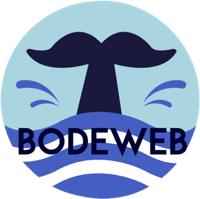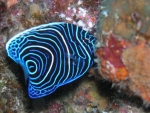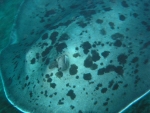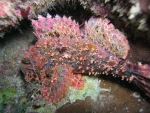When on December 26th, 2004 an earthquake measuring 9.1 on the Richter scale shook the northern part of Sumatra causing a tsunami which rolled all over the Indian Ocean and when reaching the shores killed more than 300 000 people in the area surrounding the Indian Ocean, we had already booked our flights to a destination close to the epicentre of the tsunami. During the next weeks and months we watched anxiously the news coming in from Thailand, India, Sri Lanka and even Africa. Banda Aceh, the region we wanted to visit in northern Sumatra, was the worst affected area. With more than 200 000 people killed in Indonesia we could not imagine to go there for diving only half a year later. Also we did not know whether the tsunami had caused similar destructions under water as above.
However, during the following weeks we gradually found out, that our destination, the small island of Pulau Weh only an hour´s boat ride away from the town of Banda Aceh had not suffered as much as many places on the mainland. There were "only" 12 people killed, most houses close to the beach had been destroyed but the high shores to the west and the mountainous profile of the island obviously prevented a disaster like in other areas.


Since January 2005 no more special permit is needed to travel to Banda Aceh and there is hope that after the peace treaty between the Aceh Liberation Front (GAM) and the Indonesian government in August 2005 the civil war will come to its end.

The horseshoe shaped island is mountainous with high cliffs to the west and shallow bays and beaches in the north. The main town is Sabang in the north. Most Indonesians know Pulau Weh only as Sabang.
There is a fast ferry from Banda Aceh twice a day. After less than an hour the passengers leave in Balohan in the south and it takes another 45 minutes by chartered taxi (13 Euro) on pothole covered roads to the beach of Gapang, where the Lumba Lumba Dive Centre is situated.
Divers can stay in some nearby resorts with comfortable, big sized bungalows some of them even offering ac for little money (7 - 12 Euro).
Simple Indonesian style restaurants are near the beach and you may even get your meals at the resort during weekends, when there are more guests around.
There is a fast ferry from Banda Aceh twice a day. After less than an hour the passengers leave in Balohan in the south and it takes another 45 minutes by chartered taxi (13 Euro) on pothole covered roads to the beach of Gapang, where the Lumba Lumba Dive Centre is situated.
Divers can stay in some nearby resorts with comfortable, big sized bungalows some of them even offering ac for little money (7 - 12 Euro).
Simple Indonesian style restaurants are near the beach and you may even get your meals at the resort during weekends, when there are more guests around.
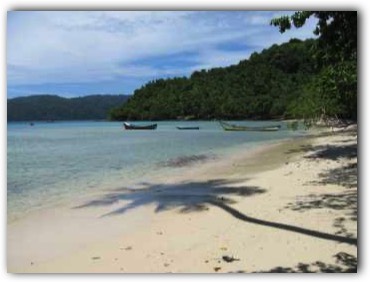
Diving in Pulau Weh
Pulau Weh is situated on the eastern border of the Indian Ocean. So you will find the typical fishlife of the region but there are also species from the more diverse indo-pacific area further east. Special current conditions also contribute to the island´s status as a regional hot spot of biodiversity.
Gerald Allen and Mark Erdmann who visited Pulau Weh in May 2005 discovered during their visit again some new species like a sand eel colony near the underwater volcano and a new species of Dottybacks (Pseudochromis sp.).
Gerald Allen and Mark Erdmann who visited Pulau Weh in May 2005 discovered during their visit again some new species like a sand eel colony near the underwater volcano and a new species of Dottybacks (Pseudochromis sp.).
Most dive sites are situated in the north-west of the island. The sites are usually small walls and slopes, nearly always covered with big boulders. On most sites there are many species of gorgonian fans and lots of green coral (Tubastraea micrantha) full of Anthias and Butterflyfishes. In the shallows there are nice coral gardens with a good diversity of hard- and soft coral. The dive sites in the west are covered with Gorgonians and soft coral.
On many dive sites big schools of fusiliers and snappers circle around. Jacks and tunas are also often to be seen. There are many species of morays around which find ideal conditions among the big boulders and rocks. You will see many giant morays, honeycomb morays and ribbon eels.
The big pelagics are also here: We met huge napoleon wrasses, blacktip reef sharks, giant groupers, eagle rays, dogtooth tuna and giant trevallies. From January until May there is a good chance to see manta rays off the west coast. In July/August however with the winds coming mainly from the west it can sometimes be difficult to reach these dive sites.
We met the green and hawksbill turtles near the reefs and there are many different kinds of scorpion fishes and many different species of nudibranchs.
Visibility was better than average and usually above 20 m. There are strong currents at several dive spots (Arus Paleh).
The big pelagics are also here: We met huge napoleon wrasses, blacktip reef sharks, giant groupers, eagle rays, dogtooth tuna and giant trevallies. From January until May there is a good chance to see manta rays off the west coast. In July/August however with the winds coming mainly from the west it can sometimes be difficult to reach these dive sites.
We met the green and hawksbill turtles near the reefs and there are many different kinds of scorpion fishes and many different species of nudibranchs.
Visibility was better than average and usually above 20 m. There are strong currents at several dive spots (Arus Paleh).
Video: Das Wrack der Sophie Rickmers
Pulau Weh has at least two wrecks on the diving agenda:
Just in front of Sabang harbour lies a small tugboat in only 14 m of water which is a good dive for critter-lovers.
The second wreck is only a few minutes away from the dive centre. It is the 134 m long former German cargo ship "Sophie Rickmers" which lies on the bottom at 54 m. An interesting dive indeed - but only for experienced divers!
Something extraordinary to be seen is the very active underwater volcano of Pulau Weh. In only 9 m depth hot gazes steam out of fumaroles from the sea floor. It is like diving through curtains of bubbles. This underwater volcano is much more impressive than the famous underwater volcano near the Sangihe Islands.
Just in front of Sabang harbour lies a small tugboat in only 14 m of water which is a good dive for critter-lovers.
The second wreck is only a few minutes away from the dive centre. It is the 134 m long former German cargo ship "Sophie Rickmers" which lies on the bottom at 54 m. An interesting dive indeed - but only for experienced divers!
Something extraordinary to be seen is the very active underwater volcano of Pulau Weh. In only 9 m depth hot gazes steam out of fumaroles from the sea floor. It is like diving through curtains of bubbles. This underwater volcano is much more impressive than the famous underwater volcano near the Sangihe Islands.
Rubiah Seagarden
This is a shallow and relaxed dive in a beautiful coral garden. Also a very good spot for night dives. We discovered a spanish dancer, some small sepia and hermite crabs. During daytime it is the usual moray eels, blue spotted stingrays, many different species of scorpionfish and nudibranchs.
Arus Balee (Widow´s Current)
The dive site is situated between the small islands of Rubiah and Seulako near a rocky pinnacle. We do not know whether the currents here have made local fishermen´s wifes to widows, but there have been some divers who had to surface far away in the blue after having been caught by the unpredictable currents at this dive site. There are always large schools of fusiliers and snappers around and the chance to see pelagics is quite good. In the sheltered areas we found many ribbon eels, blue spotted stingrays and scorpion fish.
Rubiah Utara (Rubiah North)
A dive here starts on the north point of Rubiah Island by following the rocky slope covered with big boulders to the north. There are many gorgonian fans and green coral around. If conditions are fine you may even reach Arus Balee and finish the dive there.
Batee Tokong and Shark Plateau
Batee Tokong is part of a big underwater plateau stretching to the north. Some rocks even reach the surface and form a wall down to 25 m where a plateau begins which is literally covered with big fans. We watched a giant grouper there. Further north this dive sites continues to Shark Plateau where there is a good chance to watch napoleon wrasses, giant groupers and blacktip reef sharks.
This is a shallow and relaxed dive in a beautiful coral garden. Also a very good spot for night dives. We discovered a spanish dancer, some small sepia and hermite crabs. During daytime it is the usual moray eels, blue spotted stingrays, many different species of scorpionfish and nudibranchs.
Arus Balee (Widow´s Current)
The dive site is situated between the small islands of Rubiah and Seulako near a rocky pinnacle. We do not know whether the currents here have made local fishermen´s wifes to widows, but there have been some divers who had to surface far away in the blue after having been caught by the unpredictable currents at this dive site. There are always large schools of fusiliers and snappers around and the chance to see pelagics is quite good. In the sheltered areas we found many ribbon eels, blue spotted stingrays and scorpion fish.
Rubiah Utara (Rubiah North)
A dive here starts on the north point of Rubiah Island by following the rocky slope covered with big boulders to the north. There are many gorgonian fans and green coral around. If conditions are fine you may even reach Arus Balee and finish the dive there.
Batee Tokong and Shark Plateau
Batee Tokong is part of a big underwater plateau stretching to the north. Some rocks even reach the surface and form a wall down to 25 m where a plateau begins which is literally covered with big fans. We watched a giant grouper there. Further north this dive sites continues to Shark Plateau where there is a good chance to watch napoleon wrasses, giant groupers and blacktip reef sharks.
Batee Gla
After descending to a sandy slope with many sand eels the dive continues through a labyrinth of big boulders with scenic passages in between. We saw turtles here, manthis shrimps, many morays and a giant grouper.
The Canyon
This is a fascinating, quite deep dive on the west coast of Pulau Weh. During the west monsoon it is sometimes difficult to reach as waves can become quite high during this time of the year.
Under water are beautiful rock formations. There is a cave near the southern end, a deep canyon with fan and soft coral covered walls and an arch at the northern end of the dive site.
There are usually big napoleon wrasses, schools of jacks and blacktip reef sharks around. When there is enough plankton in the water manta rays can be seen.
After descending to a sandy slope with many sand eels the dive continues through a labyrinth of big boulders with scenic passages in between. We saw turtles here, manthis shrimps, many morays and a giant grouper.
The Canyon
This is a fascinating, quite deep dive on the west coast of Pulau Weh. During the west monsoon it is sometimes difficult to reach as waves can become quite high during this time of the year.
Under water are beautiful rock formations. There is a cave near the southern end, a deep canyon with fan and soft coral covered walls and an arch at the northern end of the dive site.
There are usually big napoleon wrasses, schools of jacks and blacktip reef sharks around. When there is enough plankton in the water manta rays can be seen.
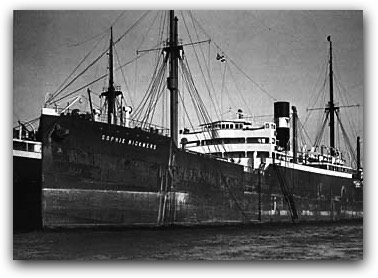
This 134 m long wreck of the "Sophie Rickmers" built in Hamburg in 1920 has been lying on the sea bed of Pria Laot Bay in Pulau Weh since May 10, 1940. The crew had sunk their cargo ship in order to prevent confiscation by the Dutch after the start of World War II.
Today the huge wreck is the home of giant groupers, giant morays and jacks. There are also pairs of the rare black-spot angelfish (Genicanthus melanospilos) around.
With the wheelhouse in 37 m, the deck at 45 m and the straight bow in more than 55 m this is not a dive for beginners! So this dive is organized as a special decompression dive with 18 minutes on the wreck and long decompression stops.
Little Wreck & Underwater volcano
The small tugboat near the harbour of Sabang lies in only 14 m of water an a sandy bottom. Visibility is far from good but it is a simple, easy dive for critter-lovers. There are pipefishes, seahorses, nudibranchs, twinspot lionfish and ghost pipefish around.
This dive is usually combined with a stop at the underwater volcano. It is a fascinating experience to dive in curtains of bubbles streaming out of the sea floor and to warm up over fumaroles in the ground. It is the most exciting underwater volcano you can dive in Indonesia!
The small tugboat near the harbour of Sabang lies in only 14 m of water an a sandy bottom. Visibility is far from good but it is a simple, easy dive for critter-lovers. There are pipefishes, seahorses, nudibranchs, twinspot lionfish and ghost pipefish around.
This dive is usually combined with a stop at the underwater volcano. It is a fascinating experience to dive in curtains of bubbles streaming out of the sea floor and to warm up over fumaroles in the ground. It is the most exciting underwater volcano you can dive in Indonesia!
The Dive Center
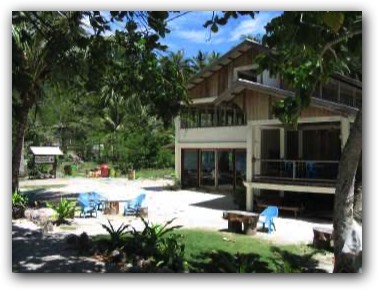
When we visited Gapang in July 2005 a lot of repair had been done and the dive centre was running well. Lumba Lumba has a good choice of well looked after dive gear. The local dive guides are attentive and know the dive sites very well.
A diving day usually starts with breakfast in one of the beach restaurants. The first dive is usually between 9.30 and 10 a.m. and the second one in the afternoon after lunch. Nightdives start after sunset at 7 p.m.
The dive sites are reached in the 120 horsepowered dive boats in a short time. Only visits to the dive spots off the west coast may last longer and may be organized as full day trips.
Contact
| Lumba Lumba Diving Center |
| Gapang Beach |
| Pulau Weh |
| PO Box 65 |
| Sabang |
| NAD, Indonesia |
| Tel/SMS/WA (shop): +62 811682787 |
| E-Mail: info@lumbalumba.com |
| Internet: http://www.lumbalumba.com |
